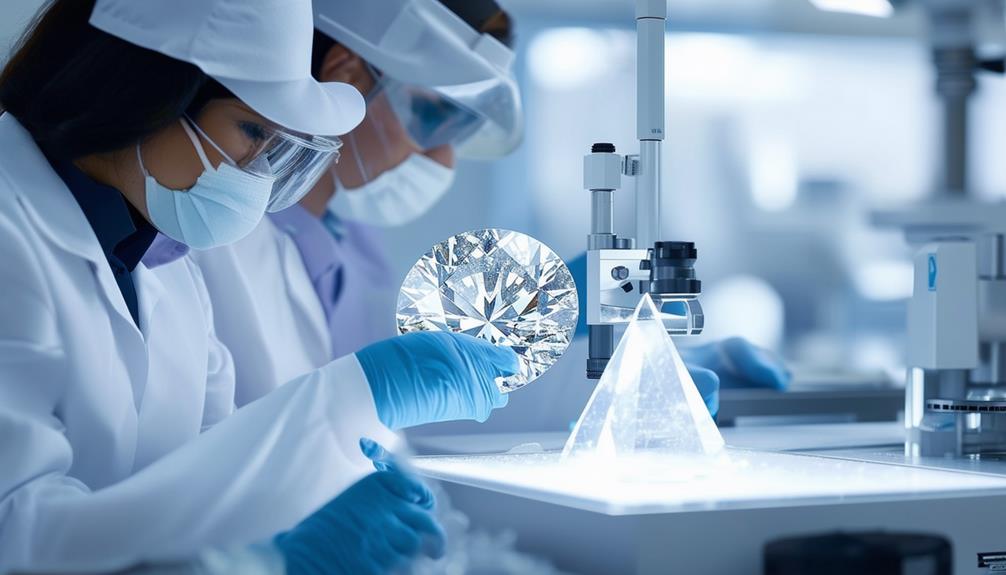Article Contents
Lab-grown diamonds are well-known for their exceptional purity, often categorised as Type IIa, which signifies the highest clarity and colour quality found in diamonds. These diamonds are created using advanced techniques such as Chemical Vapor Deposition (CVD) and High Pressure High Temperature (HPHT). These methods carefully produce diamonds that are almost entirely free from the impurities commonly present in natural diamonds.
As a result, lab-grown diamonds display unrivalled whiteness and optical properties, meeting strict quality standards that exceed those of most natural diamonds. Furthermore, opting for lab-grown diamonds promotes ethical practices within the jewellery industry by avoiding the problems associated with conflict mining. This decision not only supports sustainability but also provides a luxurious alternative for those looking for purity and responsibility in their jewellery choices.
Key Points
- Lab-grown diamonds are often classified as Type IIa, which means they have few impurities and the highest purity grade possible.
- Using controlled synthesis methods like CVD (Chemical Vapour Deposition) and HPHT (High Pressure High Temperature), these diamonds consistently show excellent clarity and colour.
- Unlike natural diamonds, lab-grown versions usually do not have the inclusions and flaws that can reduce their sparkle.
- Each lab-grown diamond goes through strict quality control and is evaluated by accredited institutions to guarantee its purity.
- Opting for lab-grown diamonds supports ethical considerations, as they do not involve the environmental and social problems associated with traditional diamond mining.
Understanding Diamond Purity
Diamond purity significantly influences a diamond's quality, and lab-grown diamonds, predominantly classified as Type IIa, exhibit higher purity compared to most natural diamonds. The Type IIa classification signifies minimal nitrogen impurities, which contributes to the diamond's superior optical qualities by enhancing its inherent brilliance and whiteness. Consequently, lab-grown diamonds consistently meet the highest standards of purity, ensuring each stone displays exceptional light reflection and uniformity.
In contrast, fewer than 2% of natural diamonds achieve this level of clarity and colour. The consistent quality of lab-grown diamonds offers a compelling option for those prioritising both aesthetic appeal and ethical considerations. These diamonds provide a responsible choice, free from the ethical concerns associated with natural diamonds, such as conflict mining and environmental degradation.
Choosing a lab-grown diamond supports ethical and sustainable values without compromising on quality. This selection ensures a high-quality, ethically sound gem that aligns with both personal aesthetics and a commitment to responsible practices.
Lab-Grown Production Techniques
Two primary techniques are used to create lab-grown diamonds: Chemical Vapor Deposition (CVD) and High Pressure High Temperature (HPHT). The CVD process involves growing diamonds layer by layer from a carbon-rich gas within a highly controlled environment, which is crucial for maintaining the purity of each layer and thus the overall quality of the diamonds. This method ensures the resulting gems are free from impurities.
In contrast, the HPHT method replicates the natural conditions under which diamonds form in the earth, by exposing a small diamond seed to extreme pressures and temperatures. This technique produces diamonds that are notable for their clarity and purity, and it eliminates the ethical and environmental concerns associated with traditional diamond mining.
Both methods produce high-quality diamonds that are superior in purity to those obtained from natural sources. The controlled conditions of these techniques allow for consistent and reliable purity assessments, making lab-grown diamonds an ethically sound and sustainable choice in luxury. These attributes position lab-grown diamonds as a symbol of contemporary sophistication and responsible luxury.
Comparing Purity Standards
Lab-grown diamonds often achieve the Type IIa purity rating, which is a standard less than 2% of mined diamonds reach. This higher purity generally results in diamonds that appear brighter and whiter. In addition, the controlled conditions under which lab-grown diamonds are manufactured help reduce defects and inconsistencies in the crystal structure, which are more common in naturally mined diamonds. This process not only meets but can exceed the quality expectations of consumers.
Moreover, lab-grown diamonds offer an ethical advantage by providing clear origin traceability, which appeals to those concerned about the environmental and ethical implications of mining. This aspect ensures consumers can make informed choices based on their values without compromising on quality. Thus, lab-grown diamonds represent a compelling option for those who prioritise both exceptional quality and ethical considerations in their jewellery purchases.
Quality Control Processes
Quality control processes for lab-grown diamonds are rigorously developed to ensure each gem adheres to high standards of clarity and colour, matching those of natural diamonds. By employing advanced technological methods, these processes confirm that each diamond attains a superior colour grade, highlighting their exceptional quality and uniformity.
Lab-grown diamonds undergo detailed purity verification to confirm their flawless characteristics, making them virtually identical to natural diamonds. This strict examination is essential to uphold the diamonds' integrity and appeal. Accredited grading reports, such as those from the Gemological Institute of America (GIA), are instrumental in certifying the quality of each diamond. These reports offer a comprehensive assessment, aiding consumers in making informed decisions with confidence regarding the authenticity and quality of their purchase.
Consumer Perceptions on Purity
In studying consumer attitudes towards diamond purity, it's essential to define what 'purity' means in the context of gemstones. Buyers' expectations regarding purity have a significant impact on their choices, with a clear trend towards choosing lab-grown diamonds.
These diamonds consistently meet the Type IIa classification, which is renowned for its exceptional clarity and lack of colour. This preference indicates a growing consumer awareness and appreciation for the excellent optical properties of these purer diamonds.
Defining Purity in Diamonds
Consumers assess diamond purity by examining its clarity, the lack of inclusions, and overall visual cleanliness. These aspects not only impact the appearance but also play a crucial role in determining the value and desirability of a diamond.
The diamond industry follows stringent guidelines that focus on these visual qualities to optimise how light interacts with the gem, thus boosting its brilliance, fire, and sparkle. Lab-grown diamonds, frequently attaining the coveted Type IIa purity grade, consistently adhere to these rigorous criteria, offering a viable alternative to natural diamonds.
For consumers who value both aesthetics and ethical considerations, lab-grown diamonds present a high-quality, ethically sourced choice.
Purity Expectations and Reality
Lab-grown diamonds, recognised for their exceptional purity, are categorised as Type IIa, which is the highest purity level achievable in diamond classification. These diamonds exhibit fewer defects and superior brightness compared to mined diamonds, whose purity levels and defect presence can vary significantly.
Despite their scientifically proven quality, consumer opinions about lab-grown diamonds are mixed, oscillating between admiration for their purity and scepticism about their authenticity and value relative to natural diamonds. This dichotomy influences consumer preferences, as some question if the synthetic origin of lab-grown diamonds impacts their inherent value.
The table below summarises the differences in purity, defect presence, and consumer perceptions between lab-grown and mined diamonds:
| Aspect | Lab-Grown Diamonds | Mined Diamonds |
|---|---|---|
| Purity Level | Type IIa (Highest) | Varied |
| Defects | Fewer | More |
| Consumer Perception | Increasingly Positive | Mixed |
This comparison highlights the distinctions in quality and public attitudes towards both types of diamonds, emphasising the high purity and fewer imperfections of lab-grown diamonds while acknowledging varying consumer perceptions.
Impact on Purchasing Decisions
The high purity of lab-grown diamonds significantly influences consumer preferences, particularly for those who value clarity and brilliance. As market trends increasingly favour purity, Type IIa lab-grown diamonds, which represent a rarity in mined diamonds with less than 2% achieving this level, are becoming a preferred choice.
This shift is driven by the guaranteed purity of lab-grown diamonds, which not only ensures a visually superior product but also aligns with modern values of luxury and ethical responsibility. This trend underscores a growing consumer awareness of quality and purity in the jewellery market, reflecting a discerning approach to value.
Advancements in Diamond Technology

Recent developments in diamond technology have significantly improved the production of lab-grown diamonds. These innovations enhance the visual appeal and structural integrity of the diamonds. They also ensure each gem adheres to the Type IIa purity standards, recognised for superior clarity and brilliance.
Moreover, environmentally friendly production methods align with contemporary ecological standards, paving the way for a harmonious balance between luxury and environmental stewardship.
Cutting-Edge Creation Methods
Recent advances in diamond synthesis, particularly through Chemical Vapor Deposition (CVD) and High Pressure High Temperature (HPHT) techniques, have significantly enhanced the production of lab-grown diamonds. These methods provide precise control over the growth and quality of the diamonds.
The CVD technique builds up diamond crystals layer by layer by depositing carbon atoms on a substrate, ensuring uniform structure and clarity. On the other hand, the HPHT method simulates the natural geological conditions necessary for diamond formation, allowing for the creation of diamonds with high clarity and purity.
Lab-grown diamonds often reach Type IIa purity levels, a classification that denotes the highest quality of diamonds with no or few impurities, which is rarely found in natural diamonds. This achievement underscores their superior quality and brilliance.
Improved Quality Control
Building on advanced techniques, modern lab-grown diamond technology incorporates stringent quality control measures. These advancements enable producers to precisely monitor and control the diamond growth process, ensuring each lab-grown diamond achieves optimal purity.
Through rigorous testing and inspection at each stage, the quality and purity of these diamonds are assured. By utilising sophisticated equipment to optimise growth conditions, producers are able to reduce imperfections significantly, often producing diamonds with a crystal structure that matches or even exceeds that of naturally mined diamonds.
These diamonds, primarily Type IIa, are noted for their virtually flawless quality. Such control not only elevates the overall quality of the diamonds but also enhances their desirability, particularly for consumers prioritising ethical and pure alternatives to mined diamonds.
Sustainable Production Techniques
Lab-grown diamonds, produced through Chemical Vapor Deposition (CVD) and High Pressure High Temperature (HPHT) methods, offer a sustainable alternative to traditional diamond mining. These methods not only maintain resource efficiency and reduce energy consumption but also significantly lower the environmental degradation and carbon emissions typically associated with diamond extraction.
Ongoing technological improvements in these processes further enhance their ecological benefits, aligning with the values of consumers who prioritise both luxury and environmental responsibility. By opting for lab-grown diamonds, individuals sidestep the ethical dilemmas linked to conventional diamond mining, promoting a more sustainable and responsible approach to luxury.
Frequently Asked Questions
Why Should You Choose Lab-Grown Diamonds?
Choosing lab-grown diamonds greatly reduces environmental damage and offers a more cost-effective alternative. These diamonds address ethical concerns and promote sustainability, all while delivering the same level of quality and brilliance as natural stones.
Why do people prefer lab-grown diamonds more than natural diamonds?
Lab-grown diamonds are preferred for their reduced environmental impact and affordability compared to mined diamonds. These diamonds address ethical concerns linked to traditional mining, providing both excellent quality and brilliance at a more cost-effective price.
Is it wise to buy lab-grown diamonds?
Purchasing lab-grown diamonds can be considered a wise choice for those prioritising ethical sourcing and sustainability. These diamonds are created in controlled environments, reducing the environmental degradation associated with traditional mining. While they offer benefits aligned with responsible consumerism, it is important to note that their investment value may differ from that of natural diamonds, as market perceptions vary.
What do experts have to say about lab-grown diamonds?
Experts praise lab-grown diamonds for their ethically responsible production and lower environmental impact, highlighting their role in promoting sustainability and addressing the environmental and ethical concerns associated with traditional diamond mining.
Conclusion
Lab-grown diamonds exemplify a significant technological achievement, combining advanced scientific methods with the timeless beauty of diamonds.
By replicating the natural conditions found deep within the Earth, labs are able to create diamonds that are remarkably pure and consistent.
For instance, the 'Flawless Future' collection by Gemesis Corp. achieves a purity level of 99.9%, establishing a new standard in the field.
This development highlights the role of lab-grown diamonds in setting new benchmarks for gemological excellence.

